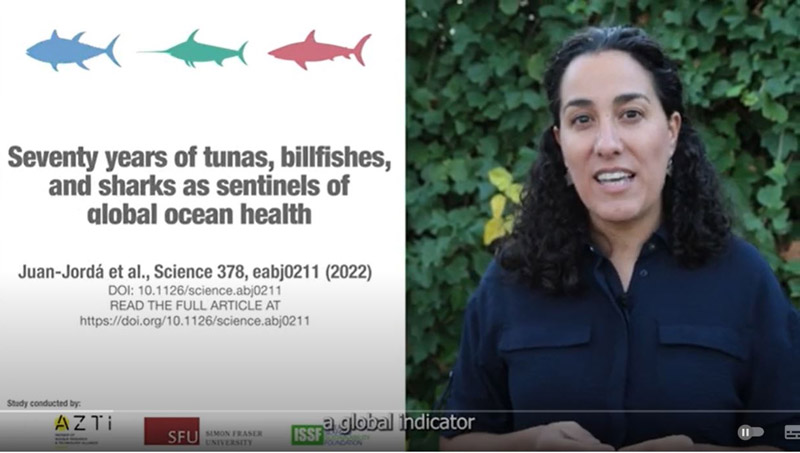Seventy years of tuna, billfish and sharks as sentinels of global ocean health
Últimas noticias
Una mirada LGTBIQ+ al reino animal
Circular Economy in Action: Valorisation of By-products through Projects like PRIMA NEWFEED
Strategic Perspectives: Highlights from the Food4Future World Summit for Business Leaders
- The AZTI technology centre, in collaboration with Simon Fraser University (SFU) and the International Seafood Sustainability Foundation (ISSF), has developed a global indicator that measures the state of marine biodiversity based on changes in extinction risk recorded over seven decades in oceanic predatory fishes.
- The results, published in the prestigious journal Science, offer some hope after the global rebuilding of commercially important tuna and billfish species, yet reveal a problem in the management of sharks captured incidentally by the same fisheries, showing the urgency of implementing actions to prevent their increasing risk of extinction.
Pasaia, 11th November 2022– Recent biodiversity studies show an unprecedented loss of species, ecosystems and genetic diversity on land, but the extent to which these patterns are widespread in the oceans is not yet known. There is therefore an urgent need, as well as a global commitment, to develop surveillance indicators to monitor the health of marine ecosystems and the possible risk of extinction of their species.
The AZTI technology centre, in collaboration with Simon Fraser University (SFU) and the International Seafood Sustainability Foundation (ISSF), has developed a new science-based indicator that seeks to fill this gap in terms of assessing the state of health of the oceans and their biodiversity.
Specifically, the research team has developed a Red List Index (RLI) of oceanic predatory fishes. It is an indicator that measures the health of marine biodiversity farther from coastal areas by monitoring and analysing annual changes over the past 70 years in the extinction risk of oceanic tunas, billfishes and sharks.

“Our Red List Index shows trends in the extinction risk of oceanic predatory fishes, the sentinels of global ocean health. This global indicator offers the bodies involved in the management of marine resources a very useful tool with a solid scientific basis to continue to make progress in the fight against the loss of biodiversity in marine ecosystems”, explains Maria José Juan Jordá, coordinator of this work at AZTI and an expert in tuna fisheries management.
The Red List Index of oceanic predatory fishes, the results of which have been published in the prestigious international journal Science, is based on the International Union for Conservation of Nature (IUCN) Red List Categories and Criteria, a widely understood system for classifying species at high risk of global extinction.
Central problem in fisheries management
To develop this global indicator of changes in extinction risk, experts have analysed historical data recorded by Regional Fisheries Management Bodies on 52 populations of 18 different species of tuna, billfish and sharks. The results revealed that shark bycatch is the main problem at the heart of tuna and billfish fisheries management.
“While target species such as tunas and billfishes are increasingly managed at sustainable levels, shark species taken as bycatch by the same fisheries continue to decline due to insufficient management actions. Unless these are not urgently implemented, their risk of extinction will continue to increase,” she adds.
In addition, the AZTI, SFU and ISSF study also connects for the first-time global annual changes in extinction risk with changes in fishing mortality over the past 70 years.
“The data show that the global trajectory of changes in extinction risk in oceanic predatory fishes is highly sensitive and responds directly to fishing mortality. We also show a strong alignment between the current Red List status and the state of fisheries exploitation of tunas, billfishes and sharks derived from the most recent assessments when making these comparisons at the same scale, and we find that mismatches among both assessments systems can be understood and explained” says Maria José Juan Jordá.
While the authors do not propose to use the Red List Index of oceanic predatory fishes to manage fish populations, the strong alignment between the Red List assessments and fisheries assessments, according to the authors of the study, removes any technical barriers to the use of the Red List Index by policy makers to monitor the global targets and commitments set by the Convention on Biological Diversity and the Sustainable Development Goals (SDGs) to halt and reverse marine biodiversity loss.
“Overfishing remains the main threat to oceanic marine biodiversity. We provide policy and decision-makers in marine resource management and conservation with a robust linked set of pressure-state indicators with continuity over time to track changes in oceanic predatory fish extinction risk, assess the state of biodiversity and trigger recovery plans,” she concludes.
The methodology used to estimate the global Red List Index of oceanic predatory fishes could also be applied to other marine fish, which would expand the representation of marine species on the IUCN Red List of Threatened species to monitor change more efficiently in marine biodiversity.
Additional media material can be accessed using this link.







